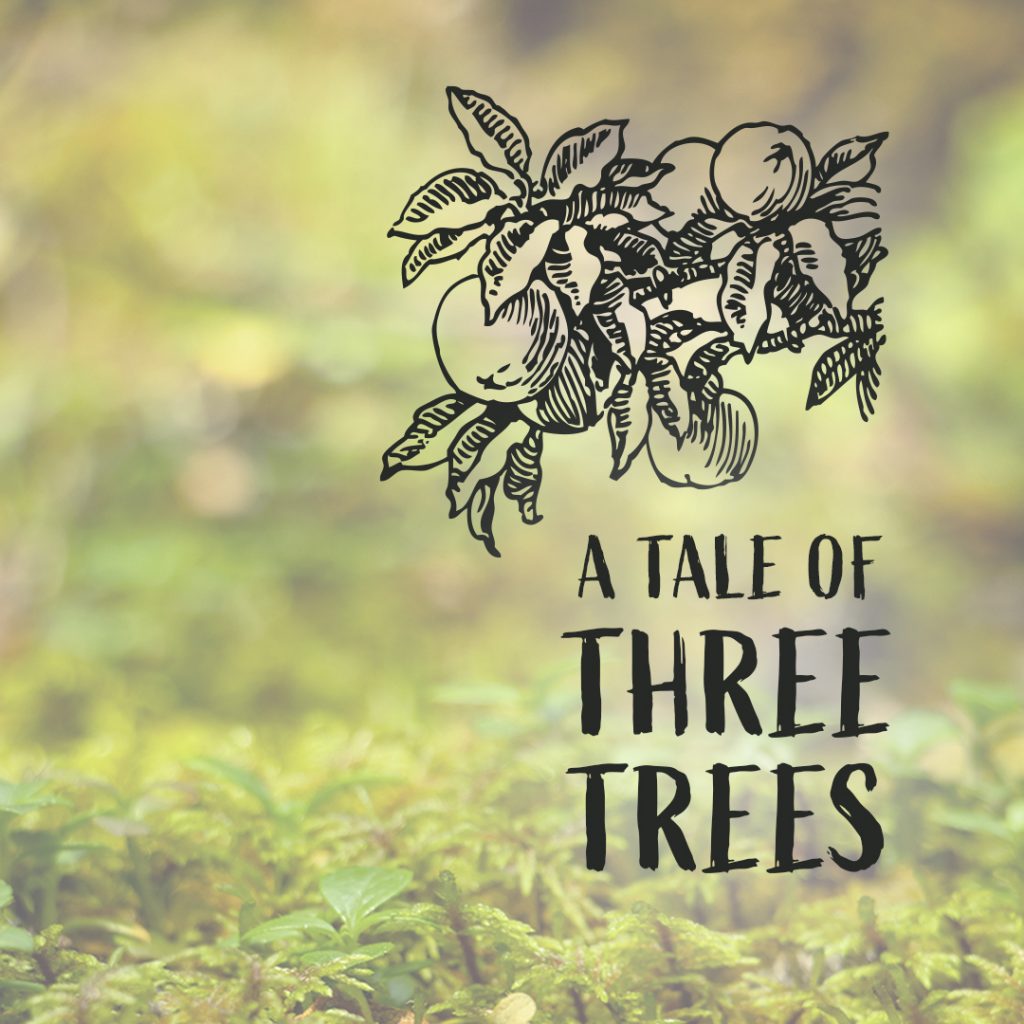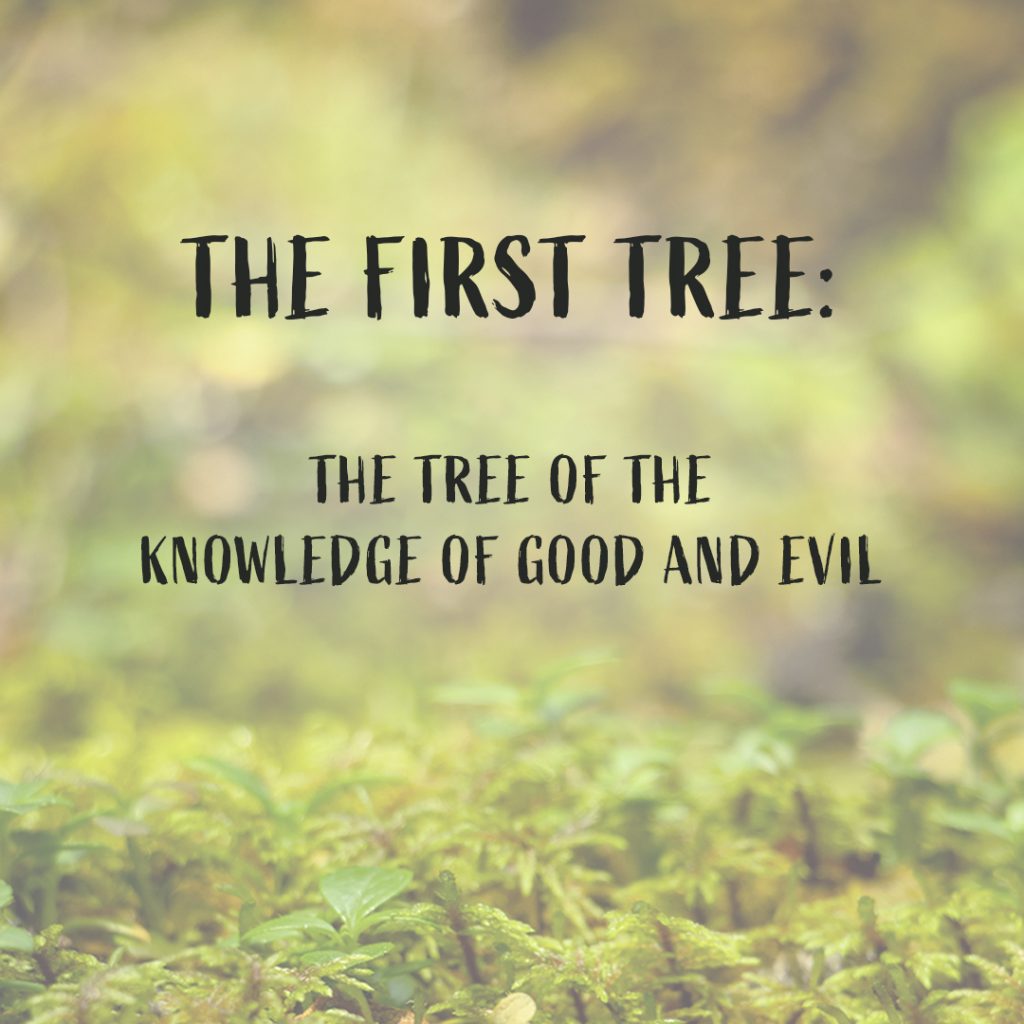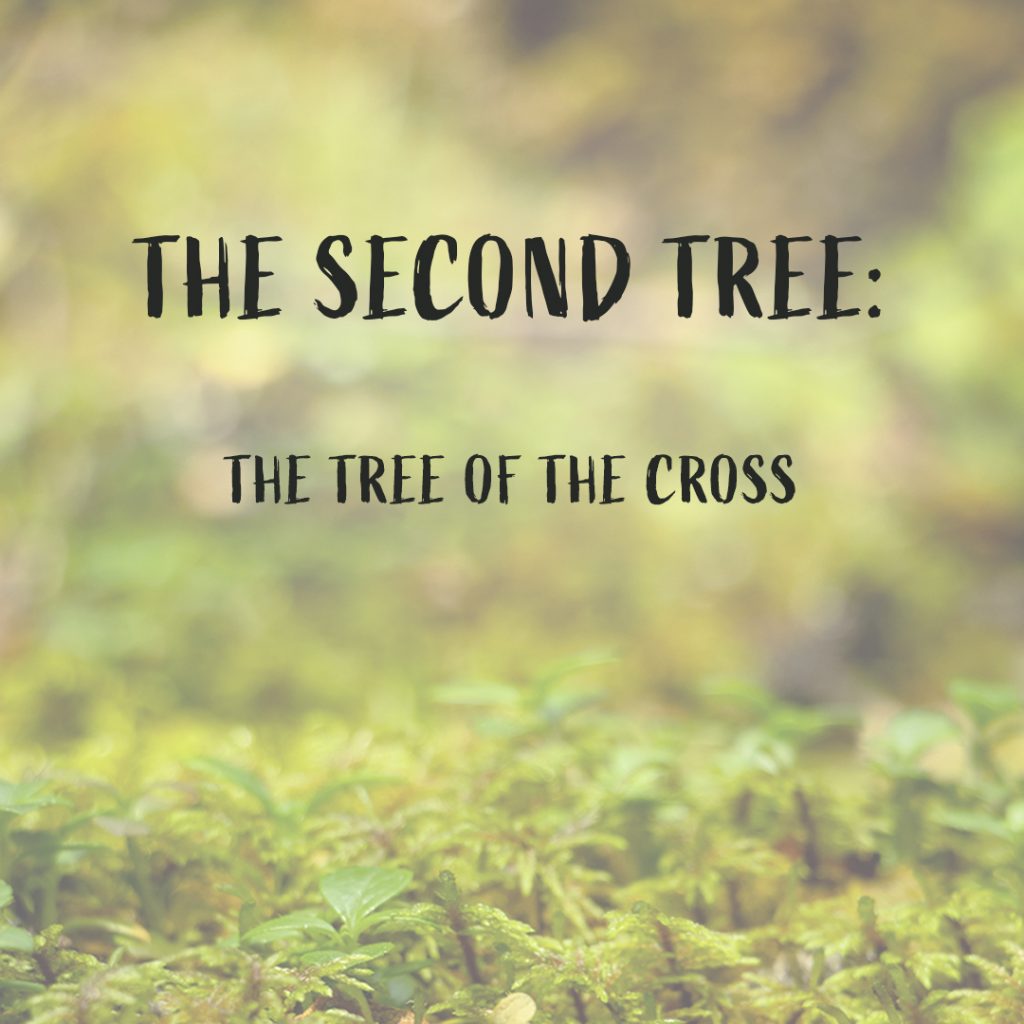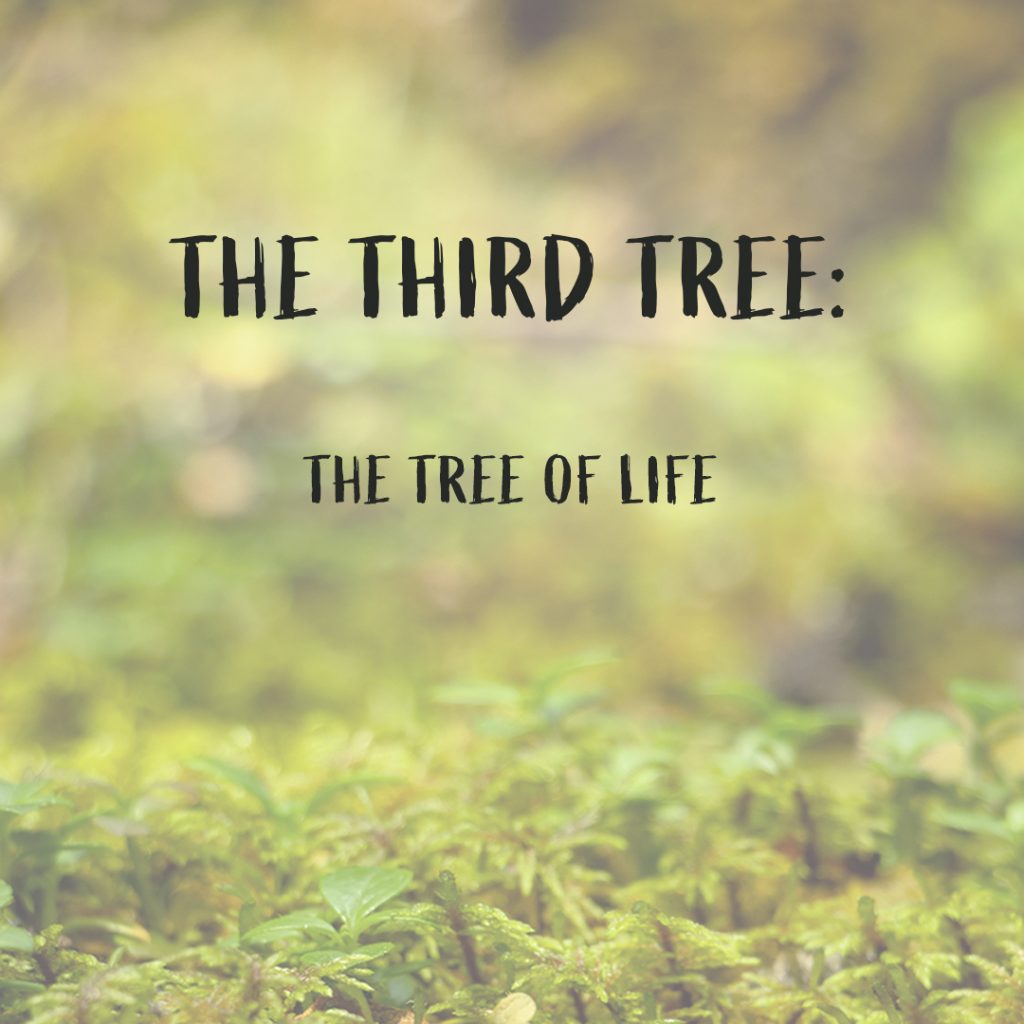A Tale of Three Trees
 by Ted Giese
by Ted Giese
In Romans 5, St. Paul puts Adam and Jesus side by side: Adam the first man and Jesus the new Adam. When we compare Adam and Jesus, we see that they both have a tree at the centre of their lives. From these two trees—the trees of Adam and Christ Jesus—we received fruit. The first fruit turned out to be sour and poisonous. It brought death. But the second fruit was sweet and holy—the antidote to the first. And through the power of this second tree, we will one day be welcomed into eternal paradise, where we will find a third tree: the Tree of Life.
The First Tree: The Tree of the Knowledge of Good and Evil
“Out of the ground the LORD God made to spring up every tree that is pleasant to the sight and good for food. The tree of life was in the midst of the garden, and the tree of the knowledge of good and evil…. The LORD God took the man and put him in the Garden of Eden to work it and keep it. And the LORD God commanded the man, saying, “You may surely eat of every tree of the garden, but of the tree of the knowledge of good and evil you shall not eat, for in the day that you eat of it you shall surely die.” – Genesis 2:9, 15-17
 This command was given to Adam before Eve was formed and, ultimately, it was his command to keep. When Eve offered him the fruit, and he took it, it was his breaking of the command that opened the door to death and brought about original sin. This eating was the origin of sin, the first human sin. The blemish of this sin passes from father and mother to child down through history and we all share in it.
This command was given to Adam before Eve was formed and, ultimately, it was his command to keep. When Eve offered him the fruit, and he took it, it was his breaking of the command that opened the door to death and brought about original sin. This eating was the origin of sin, the first human sin. The blemish of this sin passes from father and mother to child down through history and we all share in it.
What insights can we glean from the description of the Tree of the Knowledge of Good and Evil? First of all, God didn’t set Adam up to fail; the LORD gave Adam and Eve every tree that is pleasant to the sight and good for food. He didn’t give Adam just one tree and then say don’t eat of it. They had choices, thousands of trees which were all good for eating set against one forbidden tree. It’s like taking a person to a grocery store and then saying, “Eat anything here you like except the kiwis.” You wouldn’t starve for lack of that one thing. The LORD is gracious and didn’t set Adam up to fail.
We also read that, quite apart from the serpent’s temptation, the fruit of the Tree of the Knowledge of Good and Evil really did have its own allure. In examining it, Eve discovered that the “tree was good for food, and that it was a delight to the eyes, and that the tree was to be desired to make one wise” (Genesis 3:6). This tree, along with everything God had made, had been approved of and blessed by Him as “very good” (Genesis 1:31). God made nothing that was evil for there is no evil in God (1 Timothy 4:4; 1 John 1:5). Adam sinned not because the tree was evil but because he broke God’s command of how to live with the tree. Imagine a cheesecake sitting on a table. On its own, it has no power to cause you to gain weight. Tempting as it might be sitting there on the table, it cannot force you to eat it. If it gets into your body, it’s because you put it there. This is the relationship between temptation and sin, a relationship which links us all to that first temptation and sin. Without Jesus we would be eternally stuck with the aftermath of Adam and Eve’s original sin. That sin didn’t end with Adam; it obstinately spreads through time to each of us. Humanity’s fall into sin under the leaves of the Tree of the Knowledge of Good and Evil would be dreadfully hopeless without Christ Jesus and His tree.
We don’t often think of the cross on which Jesus was crucified as a tree. Sure, it’s made of wood and trees are made of wood, but we wouldn’t call a chair a tree just because it’s made of wood. On the surface, that doesn’t make much sense. But by His death, Jesus defeats death—and when you cut down a tree and build something out of the wood the wood itself dies. So, it’s rather poetic that Jesus defeats the power of death on a cross made of dead wood.
The Second Tree: The Tree of the Cross
We don’t often think of the cross on which Jesus was crucified as a tree. Sure, it’s made of wood and trees are made of wood, but we wouldn’t call a chair a tree just because it’s made of wood. On the surface, that doesn’t make much sense. But by His death, Jesus defeats death—and when you cut down a tree and build something out of the wood the wood itself dies. So, it’s rather poetic that Jesus defeats the power of death on a cross made of dead wood.
 Scripture speaks frequently of the cross as a tree. After Jesus’ ascension, the apostles were questioned by the Sadducees, who didn’t believe in the resurrection of the body. There they confessed: “We must obey God rather than men. The God of our fathers raised Jesus, whom you killed by hanging Him on a tree” (Acts 5:29-30).
Scripture speaks frequently of the cross as a tree. After Jesus’ ascension, the apostles were questioned by the Sadducees, who didn’t believe in the resurrection of the body. There they confessed: “We must obey God rather than men. The God of our fathers raised Jesus, whom you killed by hanging Him on a tree” (Acts 5:29-30).
Later, while preaching to Gentile Greeks and Romans, St. Peter says: “We are witnesses of all that [Jesus] did both in the country of the Jews and in Jerusalem. They put Him to death by hanging Him on a tree, but God raised Him on the third day and made Him to appear, not to all the people but to us who had been chosen by God as witnesses, who ate and drank with Him after He rose from the dead” (Acts 10:39-41).
Later still in Antioch, St. Paul and Barnabas preached to Jews and God-fearing Greeks and Romans: “For those who live in Jerusalem and their rulers, because they did not recognize Him nor understand the utterances of the prophets, which are read every Sabbath, fulfilled them by condemning [Jesus]. And though they found in Him no guilt worthy of death, they asked Pilate to have Him executed. And when they had carried out all that was written of Him, they took Him down from the tree and laid Him in a tomb. But God raised Him from the dead, and for many days He appeared to those who had come up with Him from Galilee to Jerusalem, who are now His witnesses to the people” (Acts 13:27-31).
St. Peter writes: “[Jesus] Himself bore our sins in His body on the tree, that we might die to sin and live to righteousness. By His wounds you have been healed” (1 Peter 2:24).
Finally, Paul links the idea of the cross as a tree back to the curse of the law, writing: “Christ redeemed us from the curse of the law by becoming a curse for us—for it is written, ‘Cursed is everyone who is hanged on a tree’” (Galatians 3:13).
Is this some sort of coincidence? No. Inspired by the Holy Spirit, these men knew what they were saying. The Tree of the knowledge of Good and Evil was involved in Adam’s fall, and from its branches grew the fruit by which all mankind became cursed by sin and death. But a tree was also the instrument of our salvation: the cross, upon which Jesus received the wages for our sin—for Adam’s sin. From the branches of the cross hung our Saviour and in the fruit of His body we now find eternal life; His body and His blood, now tangibly received in Holy Communion, provide the antidote and cure for the terminal ailment of original sin. Our baptism connects us with Jesus’ suffering and death on that tree, as well as with His burial and resurrection from the dead. It gives us entrance to heaven, in which we will someday eat of the Tree of Life.
By the work of Christ, the Christian no longer lives under the shadowy condemnation of the Tree of the Knowledge of God and Evil. Instead, we are made new in Jesus and stand under the blessed shadow of the cross of Christ.
The Third Tree: The Tree of Life
Scripture teaches that the Tree of Life, that other tree which stood in the Garden of Eden, grows also in the New Heavens and New Earth. After their original sin, Adam and Eve were barred from eating from the Tree of Life; eating from it would have cemented them in their fall, bringing about eternal death. But will we never eat from this Tree of Life? Jesus promises: “‘Behold, I am coming soon, bringing My recompense with Me, to repay everyone for what he has done. I am the Alpha and the Omega, the first and the last, the beginning and the end.’ Blessed are those who wash their robes, so that they may have the right to the Tree of Life” (Revelation 22:12-14). In Adam, we lost that right. But by the work of Christ, the Christian no longer lives under the shadowy condemnation of the Tree of the Knowledge of God and Evil. Instead, we are made new in Jesus and stand under the blessed shadow of the cross of Christ.
 In the Garden of Eden, “that ancient serpent, who is the devil and Satan” (Revelation 20:2) tempted Adam and Eve into the first sin with his sly and deceitful words. After His baptism, Jesus went into the wilderness where He too was tempted by the same serpent. But Jesus did not sin. He is the new Adam—the better Adam. He did for us all what the first Adam failed to do. This is why St. Paul writes, “For if, because of one man’s trespass, death reigned through that one man, much more will those who receive the abundance of grace and the free gift of righteousness reign in life through the one man Jesus Christ. Therefore, as one trespass led to condemnation for all men, so one act of righteousness leads to justification and life for all men. For as by the one man’s disobedience the many were made sinners, so by the one man’s obedience the many will be made righteous” (Romans 5:17-19).
In the Garden of Eden, “that ancient serpent, who is the devil and Satan” (Revelation 20:2) tempted Adam and Eve into the first sin with his sly and deceitful words. After His baptism, Jesus went into the wilderness where He too was tempted by the same serpent. But Jesus did not sin. He is the new Adam—the better Adam. He did for us all what the first Adam failed to do. This is why St. Paul writes, “For if, because of one man’s trespass, death reigned through that one man, much more will those who receive the abundance of grace and the free gift of righteousness reign in life through the one man Jesus Christ. Therefore, as one trespass led to condemnation for all men, so one act of righteousness leads to justification and life for all men. For as by the one man’s disobedience the many were made sinners, so by the one man’s obedience the many will be made righteous” (Romans 5:17-19).
King Solomon tells us that “the fruit of the righteous is a tree of life” (Proverbs 11:30). By way of the Tree of the Cross—through His righteousness—Jesus leads you to the promised healing of the Tree of Life in eternity, “with its twelve kinds of fruit, yielding its fruit each month” (Revelation 22:2). For all those redeemed and forgiven by Christ, eating from this tree will no longer bring death; it brings life—eternal life in Christ.
———————
Rev. Ted Giese is lead pastor of Mount Olive Lutheran Church in Regina.





